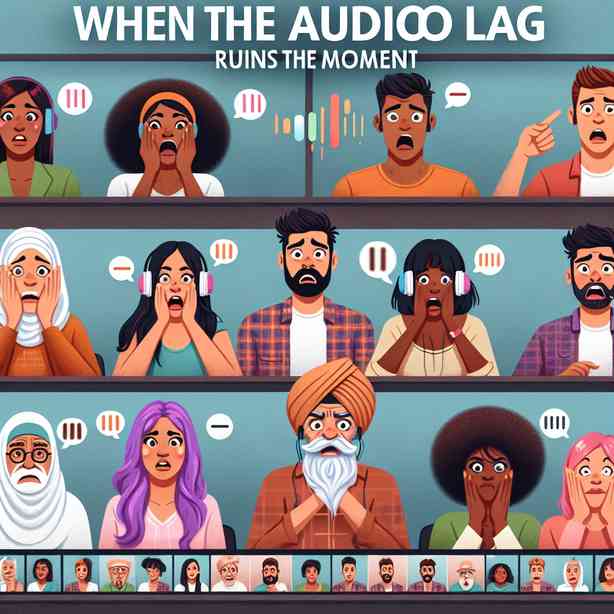
Audio lag, or latency, is a common challenge in both digital and analog audio systems. It refers to the delay that occurs between the input of an audio signal and its output. This timing discrepancy can severely disrupt experiences, whether during live performances, gaming, or even casual video watching. In this discussion, we will delve into the causes and effects of audio lag, the various contexts in which it arises, and strategies to mitigate this frustrating issue.
Understanding audio lag begins with recognizing the technological components involved in sound production and playback. Whenever sound is recorded, processed, or transmitted, it goes through various stages, such as conversion from analog to digital formats and back again, which naturally introduces some delay. For instance, in digital sound systems, the process of digitizing audio, editing it, and then converting it back to analog can contribute to noticeable latency. Common sources of audio lag include wireless connections, inefficient software, or hardware limitations.
In the realm of live performances, audio lag can be particularly detrimental. Musicians rely on real-time feedback to synchronize with each other, and any delays can lead to a disjointed experience for both performers and their audience. Imagine a scenario where a guitarist strums a chord, but the sound reaches the audience moments later, disrupting the overall rhythm of the piece. This lack of synchronization can lead to confusion among band members, resulting in a less cohesive performance.
Similarly, in gaming, audio lag can enhance or ruin gameplay experiences. For gamers who rely on precise sound cues to determine the location of in-game threats or to coordinate strategies with teammates, any delay can be the difference between victory and defeat. For example, if a player hears the sound of footsteps a second after the enemy has already passed, it hampers their ability to react accordingly. This audio delay can lead to frustration, breaking immersion and affecting overall gaming enjoyment.
In the context of professional audio production, where every millisecond counts, audio lag can pose significant challenges. Producers and sound engineers often work with multiple tracks, and delays introduced during mixing and editing can result in phase issues or a loss of clarity in the final product. Attention to detail is crucial, and even minor discrepancies can alter the auditory perception of the mix. As such, understanding how to minimize audio lag becomes essential for achieving high-quality sound.
There are several techniques one can employ to address audio lag in various scenarios. First and foremost, it is advisable to assess the hardware and software being utilized. For instance, when using Bluetooth audio devices or wireless microphones, ensure they are of high quality and compatible with the devices they are being paired with. Lower-end models often suffer from higher latency, which can lead to synchronization issues. Opting for wired connections when possible can also help provide a direct and reliable audio stream.
In terms of software, many digital audio workstations (DAWs) come with various settings to help reduce latency. Adjusting buffer sizes or using direct monitoring features can significantly improve response times for real-time audio applications. Furthermore, keeping software updated ensures that users benefit from the latest improvements and fixes aimed at reducing audio latency.
Another important factor in combating audio lag is understanding the settings of the devices being used. Most modern devices, whether smartphones, tablets, or computers, provide options to adjust audio output settings. Setting the output to the lowest possible latency can reduce the delay experienced during playback. Advanced users might explore audio interfaces and dedicated sound cards, which generally provide better performance than integrated audio solutions.
For live performances, sound engineers often use monitoring systems to prevent audio lag from affecting musicians on stage. In-ear monitors can provide real-time audio feedback to performers, allowing them to hear themselves and others without the delay commonly associated with traditional monitor speakers. Additionally, musicians can position their amplifiers and monitors strategically to minimize the distance between them and the sound source.
Despite all preventive measures, there will be times when audio lag becomes unavoidable, particularly in complex setups or during high-demand scenarios. In such cases, fostering a culture of adaptability and understanding among performers and audience members can lessen the impact. Musicians can work together to create arrangements that account for potential delays, ensuring that they remain engaged with each other and the audience.
As we move through contemporary society, where audio-visual integration plays a dominant role in communication and entertainment, it becomes increasingly crucial to address the issue of audio lag effectively. Whether it’s during a live concert, a gaming session, or while enjoying a movie, the relationship between sound and visual elements must be harmonious. Taking the time to understand and address the underlying causes of audio lag empowers users to enhance their experiences and ultimately leads to greater satisfaction.
In conclusion, audio lag is an issue that affects various domains, from gaming to live performances to audio production. Understanding its causes and implementing strategies to mitigate its impact can significantly improve the overall experience. By investing in quality hardware, adapting software settings, and fostering communication amongst team members, it becomes feasible to eliminate or reduce audio delays to a manageable level. Doing so ensures that each moment is truly memorable, allowing individuals to immerse themselves in the sounds and experiences that define entertainment and communication today. Through this understanding and proactive approach, we can minimize the risk of audio lag ruining the moment.


